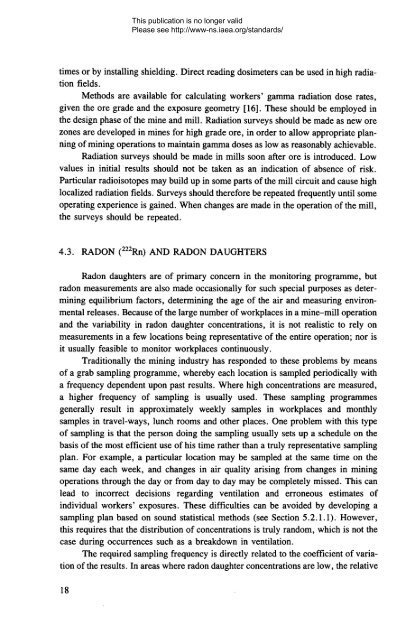IAEA SAFETY GUIDES - gnssn - International Atomic Energy Agency
IAEA SAFETY GUIDES - gnssn - International Atomic Energy Agency
IAEA SAFETY GUIDES - gnssn - International Atomic Energy Agency
You also want an ePaper? Increase the reach of your titles
YUMPU automatically turns print PDFs into web optimized ePapers that Google loves.
This publication is no longer validPlease see http://www-ns.iaea.org/standards/times or by installing shielding. Direct reading dosimeters can be used in high radiationfields.Methods are available for calculating workers’ gamma radiation dose rates,given the ore grade and the exposure geometry [16]. These should be employed inthe design phase of the mine and mill. Radiation surveys should be made as new orezones are developed in mines for high grade ore, in order to allow appropriate planningof mining operations to maintain gamma doses as low as reasonably achievable.Radiation surveys should be made in mills soon after ore is introduced. Lowvalues in initial results should not be taken as an indication of absence of risk.Particular radioisotopes may build up in some parts of the mill circuit and cause highlocalized radiation fields. Surveys should therefore be repeated frequently until someoperating experience is gained. When changes are made in the operation of the mill,the surveys should be repeated.4.3. RADON (222Rn) AND RADON DAUGHTERSRadon daughters are of primary concern in the monitoring programme, butradon measurements are also made occasionally for such special purposes as determiningequilibrium factors, determining the age of the air and measuring environmentalreleases. Because of the large number of workplaces in a mine-mill operationand the variability in radon daughter concentrations, it is not realistic to rely onmeasurements in a few locations being representative of the entire operation; nor isit usually feasible to monitor workplaces continuously.Traditionally the mining industry has responded to these problems by meansof a grab sampling programme, whereby each location is sampled periodically witha frequency dependent upon past results. Where high concentrations are measured,a higher frequency of sampling is usually used. These sampling programmesgenerally result in approximately weekly samples in workplaces and monthlysamples in travel-ways, lunch rooms and other places. One problem with this typeof sampling is that the person doing the sampling usually sets up a schedule on thebasis of the most efficient use of his time rather than a truly representative samplingplan. For example, a particular location may be sampled at the same time on thesame day each week, and changes in air quality arising from changes in miningoperations through the day or from day to day may be completely missed. This canlead to incorrect decisions regarding ventilation and erroneous estimates ofindividual workers’ exposures. These difficulties can be avoided by developing asampling plan based on sound statistical methods (see Section 5.2.1.1). However,this requires that the distribution of concentrations is truly random, which is not thecase during occurrences such as a breakdown in ventilation.The required sampling frequency is directly related to the coefficient of variationof the results. In areas where radon daughter concentrations are low, the relative18
















